Thursday, November 5, 2015
The Complete History of Yamaha Motor Company

Yamaha was founded by its corporate predecessor, Nippon Gakki (Japan Musical Instrument Manufacturing Company), when the latter elected to enter the motorcycle business in 1955. Nippon Gakki was founded in 1897 in Hamamatsu, Shizuoka prefecture, by Yamaha Torakusu (born 20 May 1851). Yamaha was the son of a samurai and had studied horology, the science of timekeeping devices, under a British engineer in Nagasaki in 1868.
Watches and clocks were imported to Japan at that time, but lacking the necessary investment capital Yamaha was unable to take advantage of the domestic market for them. In July 1887, however, the headmaster of a local elementary school called upon Yamaha to repair its organ, and Yamaha went on to build his first reed organ in the same year. He founded the Yamaha Wind Instrument Works in Naruko-cho, Hamamatsu, in March 1888.
As orders for organs came in, the firm grew steadily from ten employees at the outset to roughly one hundred within a year. In 1890, the company’s capital stock reached ¥50,000 and Yamaha erected a new factory for the production of organs in Itaya-cho, Hamamatsu. In April of that year, its organ placed second at Japan’s third National Industrial Encouragement Exhibition.
These exhibitions involved a variety of different branches of manufacturing and were tremendously important to Japan’s burgeoning industrial community. Around the turn of the twentieth century they were staged at irregular intervals ranging from one to seven years. Like machines and automobiles, musical instruments required extreme precision and craftsmanship to produce, and Japan’s government sought to encourage firms in this industry, often by purchasing the winning entries for the Imperial Household Ministry. Thereafter, Yamaha’s domestic sales increased steadily, and the company records its first export sale of eighty-seven organs to Southeast Asia in 1892. When the firm incorporated as Nippon Gakki on 12 October 1897, its capital stock increased to ¥100,000.
Nippon Gakki began to research the manufacture of pianos in 1899 and began producing upright pianos the following year after acquiring the necessary parts and equipment. The company’s first grand piano was completed in 1902, and that year Nippon Gakki took top honours at the fifth Industrial Encouragement Exhibition for both its piano and organ designs. With the rise in the company’s woodworking skills, Nippon Gakki sought to diversify its products and began producing high-end wooden furniture in 1903.
In the following year, its piano was awarded the grand prize at the World’s Fair in St. Louis, which was a tremendous technical achievement given the extreme precision required to produce a world-class instrument of that scale. Nippon Gakki’s capital stock reached ¥600,000 in 1907, and in 1909 the company opened a store in Takegawamachi, in the Kyo¯bashi ward of Tokyo. Over the next several years the firm added phonographs, pipe organs, and harmonicas to its product line; its harmonicas shipped worldwide by 1914.
In 1917, president Yamaha Torakusu died at the age of sixty-four and was succeeded by Amano Chiyomaru. From this point the company began to expand and diversify rapidly. Nippon Gakki absorbed the Yokohama-based Nishikawa Musical Instrument Company in 1921 and added that firm’s Yokohama organ factory to its operations. In that year a branch office was opened in Kobe, followed by stores and offices in Osaka in 1922, Fukuoka City in 1925, and Taiwan in 1926. In 1923, in expectation of further sales in China, the company founded a store in Dalian and established a China sales division with ¥500,000 in operating capital.
Although Nippon Gakki’s operations were idled by a month-long strike by the Hamamatsu branch of the National Federation of Labour Unions beginning on 26 April 1926, the company succeeded in ending the walkout and resuming production in May. (Coincidentally, the union’s Hamamatsu branch was founded by Tsumura Juhei, who was an employee of the Suzuki Loom Works.) Nippon Gakki’s piano fabrication shop was staffed at the end of the 1920s by master carpenters and was not automated.
Meanwhile, during this phase of steady growth in sales, distribution, and engineering capability, in 1921 Nippon Gakki branched out yet again into a new and highly advanced product : propellers, specifically for fighter aircraft. The company’s steady refinement of its propeller manufacturing processes enabled it to acquire both the milling machines and the technical skills needed after the war to enter and compete successfully in Japan’s motorcycle industry. But the engineering experience earned by Nippon Gakki during this period is a subject to which Yamaha alludes only very briefly today. The design and manufacture of wooden propellers was a job uniquely suited to a maker of pianos and furniture, for these products all required accurate cutting, planing, sanding, and lacquering by experienced woodworkers.
In August 1921, Nippon Gakki’s capital stock had reached ¥3.48 million, and in 1922 the company moved its head office and its factory to a vast new manufacturing plant at 10-1 Nakazawa-cho¯ in Hamamatsu, where it is still located today. When president Amano Chiyomaru retired in April 1927, he was succeeded by Kawakami Kaichi (born 1 March 1885), who oversaw Nippon Gakki’s operations right through the war era.
With Japan’s invasion of Manchuria on 18 September 1931, the demand for propellers increased, and Nippon Gakki began to produce metal propellers at the request of the military. In order to improve upon its manufacturing processes, in 1933 the company sent a group of its engineers to Europe and the United States to observe the production of propellers there. The casting and milling of metal propellers required a significant investment in machine tools, and gradually this job became a major priority. After Japan’s invasion of China on 7 July 1937, Nippon Gakki found itself increasingly beholden to the military’s demands and correspondingly less able to produce musical instruments. In order to satisfy the demand for propellers, each of which took a week to produce, the company curtailed its production of pianos and organs.
In November 1937, a new plant was opened north of Hamamatsu at Tenryu City, where a modest number of smaller musical instruments continued to be produced. In that year, the president’s son, Kawakami Genichi (born 30 January 1912), joined Nippon Gakki as a production supervisor, having graduated from the Takachiho Higher School of Commerce in 1934. Genichi joined the firm at a challenging time. The National General Mobilization Law of April 1938 placed Nippon Gakki’s equipment, employees, and operating capital under the supervision of the Imperial Japanese Army. The company’s sawing and veneer departments were shut down, and piano and organ production therefore ceased. Nippon Gakki’s
principal task became the production of propellers and auxiliary fuel tanks for military aircraft.
As the firm’s new propeller research and production program went into operation, Nippon Gakki’s capital stock increased to ¥8.75 million and the company was designated a munitions factory. Despite these developments, Nippon Gakki managed to continue producing enough smaller musical instruments to warrant opening new stores in Nagoya, occupied Seoul, and Manchukuo in January 1940.
In September 1941, Nippon Gakki’s capital stock increased to ¥17.5 million, and after war with the United States broke out on 8 December, the demand for propellers rose once more. The company embarked upon an expansion plan that included the acquisition of a site in nearby Iwata City, Shizuoka prefecture, as well as the construction of a factory in Kitakami City, Iwate prefecture. The company was also ordered by the military to produce metal Hamilton Standard-type variable-pitch aircraft propellers for large bombers, which could be adjusted when the aircraft was on the ground. The manufacture of these metal propellers was laborious and time consuming, and by 1943 Nippon Gakki was in search of a way to automate the process. The president advised his materials section manager, Kubono Shinobu, that because Kubono was more familiar with business than with engineering, he should seek the advice of Honda Soichiro. Kubono did so, and though Honda was already a busy man, he agreed to assist Nippon Gakki with the automation of its propeller production system.
A talented engineer, Honda designed efficient cutting machines that could mill the surfaces of two propellers at the same time – in only thirty minutes. The principal financier of such research and design projects was, of course, the state, and much of its investment in wartime munitions manufacturing formed the basis for Japan’s foray into passenger car, truck, and motorcycle production after the war. Nippon Gakki’s propeller-cutting machinery, like the skills it earned casting and grinding metal propellers, was tremendously important for the company’s postwar operations.
Following the defeat of the Imperial Japanese Navy at Midway in June 1942, Japan’s strategic position against the United States worsened steadily. In October of that year Nippon Gakki’s plant in Nakazawa, Hamamatsu, was placed under the control of the navy, and its Tenryu¯ plant came under joint army-navy control. Orders for propellers fell 10 percent in August 1943, and the manufacture of musical instruments was officially halted in November 1944.
Although the company’s capital stock increased to ¥30 million in the following month, production was interrupted on 7 December by the To¯nankai earthquake, which killed three workers and injured thirteen more. Moreover, the entire Nakazawa manufacturing plant was demolished : not one supporting column remained upright. In spite of the apparent scale of the destruction, however, all of the buildings’ foundations and floors, which were concrete, remained unbroken. For this reason, it was estimated that the workers could rebuild the plant within a month, and following a massive group reconstruction effort, production indeed resumed in the rebuilt factory on 15 January 1945.
Through the first half of that year, Hamamatsu was bombed with increasing frequency by US B-29s, and like the Suzuki Loom Works, Nippon Gakki began arranging to evacuate its facilities in order to safeguard its operations. In April 1945, the equipment in the company’s propeller manufacturing department was set up both in a nearby cedar forest and inside tunnels dug into the mountainside near Hamamatsu. Shortly afterward, Nippon Gakki’s music shops in Nagoya, Osaka, and Kobe were lost when those cities were destroyed in incendiary bombing raids, and the company’s Tenryu factory was bombed on 19 May.
On the same day, seven bombs fell on the Nakazawa complex, destroying the musical instrument shop, the casting plant, and the woodworking shop. An area of 33,000 square metres (355,209 square feet) was burned in all. On 29 July, the Hamamatsu area came within reach of US naval artillery, which shelled Nippon Gakki’s remaining offices and factories at Tenryu and Nakazawa, shortly after which both sites were again struck by B-29s. Finally, Nippon Gakki evacuated its offices to Funagira, Tenryu. When Japan surrendered on 15 August, the company’s manufacturing operations, which had once employed over ten thousand workers, halted.
In the postwar era, Nippon Gakki recovered by producing small musical instruments. In October 1945, it resumed the manufacture of harmonicas and xylophones, and it began issuing accordions, horns, and guitars in 1946. On 18 June 1946, Emperor Hirohito, escorted by US military personnel, visited the company’s Hamamatsu plant to inspect its operations and its many musical instruments during one of several such tours about the country. This visit parallels that by Crown Prince Akihito to the Miyata Manufacturing Plant in the same year. Two months later, in August 1946, president Kawakami Kaichi was informed of his imperial nomination to Japan’s House of Peers. It is difficult to overlook the postwar nomination of the president of a former munitions corporation to the unelected upper house of Japan’s legislature, for the political continuum is striking. Nevertheless, on 6 October, the House of Peers voted 298 to 2 in favour of the Bill for Revision of the Imperial Constitution, which replaced the House of Peers with an elected House of Councillors. Emperor Hirohito promulgated Japan’s new constitution on 3 November 1946. When it went into effect six months later, Kawakami ran for his seat. His position as both an incumbent and a captain of industry provided the means necessary to run a successful campaign, and he was elected by his prefectural constituents in April 1947.
Nippon Gakki had resumed its export of harmonicas in January 1947 when it shipped twenty-four thousand units to the United States. As production expanded, the company closed its manufacturing plant in Iwate prefecture in February 1948 and rebuilt the casting plant at its home office in Nakazawa-cho in April. The construction of a new casting plant was a significant postwar milestone that once again enabled the company to cast its own machine parts, without which it would have had to depend on outside suppliers. Production of short, upright spinet pianos was under way by the spring, and their exports began in July. The firm’s capital stock, which had stood at ¥30 million in December 1944, reached an impressive ¥100 million by March 1949, putting it in a strong financial position in relatively short order. During this period, Nippon Gakki managed to survive in an industry that had converged from 126 musical instrument manufacturers to just 49.
When Nippon Gakki’s third-generation president, Kawakami Kaichi, became company chairman in September 1950, his thirty-eight-year-old son, Genichi, became president. Genichi had risen quickly to become the manager of Nippon Gakki’s Tenryu¯ factory during the war, and at the time he became president he was the company’s senior general manager. Like his peers Honda Soichiro and Suzuki Shunzo, he was a highly experienced manager with an understanding of mass-production systems born of wartime necessity. The pressures associated with curtailing Nippon Gakki’s manufacture of musical instruments and the expansion and automation of its propeller production processes occurred during Kawakami Genichi’s tenure. His assumption of the presidency also came at a more fortunate time than the point at which he had joined Nippon Gakki in 1937. Sales of musical instruments were rising steadily, and within three years of his becoming president, the firm had opened sales headquarters in Tokyo and Osaka and its capital stock had tripled to ¥300 million.
The opportunity for Nippon Gakki to enter the motorcycle market came as Japan’s obligation to pay war reparations to East Asian nations was sharply curtailed. In 1948, Washington cancelled 90 percent of proposed reparations payments by Japan in the category of heavy industry and 60 percent in the munitions industry, in order to shore up the Japanese economy and prevent a possible Communist takeover.102 Japan’s obligation to pay reparations was further limited upon the signing in San Francisco of the Treaty of Peace with Japan on 8 September 1951 – a document known commonly as the San Francisco Peace Treaty. Although Japan eventually paid over ¥1 trillion in reparations and offered development aid to those nations that waived their right to collect the indemnity, many of the munitions manufacturers that had expected to make payments were absolved of that responsibility by the early 1950s.
This freed up many former munitions corporations to invest in their own operations. Yamaha records that Japan’s defeat came “tied together” with a proposed regime of reparations payment but that this obligation was later “loosened.”103 As a result, in May 1953, Nippon Gakki purchased a 1,700-square-metre (18,300-square-foot) site at Hamakita-machi, in Hamana-gun, Shizuoka, for a new manufacturing
plant. Into this new plant Nippon Gakki moved the high-efficiency cutting and milling machines that it had used to produce aircraft propellers – machines that had been sitting idle and under wraps since the war.
In July 1953, Kawakami Genichi left Japan for a ninety-day inspection tour of Europe and the United States, where he was shocked both by the level of automation in Western factories and by people’s comparatively high living standards. He returned to Japan convinced that he would have to develop an altogether new business. Although designed originally to make propellers, Nippon Gakki’s cutting machines had a great many potential applications, which Kawakami and his technicians set about researching. Together with the section chiefs of the firm’s casting plant and of its machine tool department, Kawakami considered producing sewing machines or transmissions, but the group concluded that there were already too many manufacturers of those products.
Next they thought about building scooters, but Fuji and Mitsubishi already dominated that market with their Rabbit and Silver Pigeon. Three-wheeled utility vehicles were also rejected because Daihatsu and Orient Industries (later Mazda) had a firm grip on that sector. Kawakami then decided that although Nippon Gakki might be a latecomer, it would compete against Honda and Suzuki in the motorcycle industry. Shortly thereafter, the chief of Nippon Gakki’s research section and the head of its engineering department were dispatched on an inspection tour of the top motorcycle manufacturing companies in Japan. This was not an uncommon practice, for the Hamamatsu Motorcycle Manufacturers’ Association founded by Suzuki and Kitagawa Motors had begun sponsoring such efforts to improve the technical capabilities of member firms and new market entrants.
What Nippon Gakki’s observers learned, however, was sobering. They could see that there was still a large disparity in quality between Japanese motorcycles and those produced overseas, and for this reason Nippon Gakki’s research and development group set its sights on the manufacturing standards of the world industry leaders. The key to success, they determined, lay in producing a machine that was equivalent to the best being manufactured in Europe, not in Japan. Kawakami’s firm was financially prepared to make the investment in developing a competitive product, but he wanted to be certain that his company could find a niche in the still-populous market. The product development team was well aware that domestic industry leaders like Honda were producing four-stroke engines, but those machines, while more powerful, had more complex parts than two-stroke engines and were also much more difficult to build. Two-stroke engines, meanwhile, were often more reliable, and Kawakami’s team therefore settled on the two-stroke engine as their design of choice.
In 1954, two of Nippon Gakki’s engineers toured motorcycle production plants in West Germany and elsewhere in Europe before they tackled the job of building their own prototype. This research, which mirrors that undertaken by Honda Soichiro as he too toured American, British, and European motorcycle factories in the summer of 1954, was a critical dimension of Nippon Gakki’s development strategy. The team was impressed most by German designs, and it set its sights on a two-stroke, 125 cc motorcycle by the German firm DKW that had already been copied in the postwar era by a variety of companies. These included Harley-Davidson and the British firm BSA, both of which had been
given the design schematics as part of the war reparations paid by Germany to the United States and Great Britain. The 125 cc DKW was a patent-free design the war, which made reproducing it easier, and it was also an attractive motorcycle with a very reliable engine. Based upon that design, Nippon Gakki’s development team began work on a prototype in October 1953.
The designers cast their own parts and used the company’s war-era cutting machines to mill and finish them, giving them total control over the production of such critical components as the crankshaft, connecting rod, cylinder, and crankcase. As a wartime manufacturer of auxiliary fuel tanks for aircraft, Nippon Gakki had little trouble designing an appropriate fuel tank for its prototype – a job that had given Honda’s engineers considerable difficulty when designing their A-Type motorcycle in 1947. (Honda’s first aluminum tanks were riddled with tiny holes. To prevent them from leaking fuel, coats of extremely noxious lacquer had to be applied, which made several employees very ill.) Nippon Gakki’s initial casting know-how and equipment were far superior to those of its rival. In August 1954, the team produced the YA-1, an air-cooled, two-stroke, 125 cc machine with a two-tone colour scheme in maroon and ivory – earning it the nickname "Aka-tombo", or "Red Dragonfly".
The new prototype was put through a rigorous ten-thousand-kilometre endurance trial in order to be certain that it could be sold to the public without suffering mechanical breakdowns. The design performed well and, satisfied with its sales potential, in December 1954 Kawakami Genichi gave the go-ahead for full-scale production. In that month the company added a paint shop and an electrical components shop to its factory in Hamakita, which it named the Hamana plant. As Nippon Gakki had already established a series of music stores and business offices from Hiroshima to Sendai, building a nationwide motorcycle dealer network was less costly than for firms with no corporate presence in distant parts of Japan.
When the Yamaha YA-1 went on sale in February 1955, customers responded well, and pleased with its market debut, Kawakami founded the Yamaha Motor Company, Inc., on 1 July 1955. The new company had 275 employees, and, armed with an initial ¥30 million in capital stock, it was expected by its founder to be a market leader. In order to secure that position, Yamaha’s engineers were well aware that their design would have to perform exceptionally in that month’s Mount Fuji Ascent Race.
Yamaha’s racing development team was fortunate to have a laboratory that featured a dynamometer for measuring torque and rotational speed, with which they were able to calculate horsepower. Each day the team plotted graphs of their engines’ performance as Kawakami pressed them to boost the YA-1’s output from 5 to 10 horsepower. Problematically, however, the race lab was tucked into a corner of Yamaha’s pipe warehouse alongside a row of its war-era cutting machines, where the temperature soared on summer days. Because hot air burns less efficiently than cooler air, the race engineers were forced to work late into the night in order to get decent results. The horsepower of the engines peaked around midnight, once the temperature had cooled, which meant that its race technicians typically went home at one or two o’clock in the morning. The race team also employed the dynamometer in a uniquely deceptive strategy.
On the day before most races, the riders of all the competing firms would usually go out and test the course, but the Yamaha team did not take advantage of this opportunity to practise because of the possibility of random engine trouble. Instead, its riders preferred to be seen drinking sake and enjoying themselves. But the Yamaha team would bring along a portable chassis dynamometer with which to test its engines. The team kept the dyno “camouflaged” until race day, when they would set it up just before the start of the event. The team then ran each of their motorcycles as a stationary bike and recorded the data needed to determine peak horsepower output. Whatever the altitude or temperature, the engineers could tune the engine’s ignition timing and set up the carburetor for maximum performance without subjecting the rest of the bike to wear and tear on the track. When the other teams turned around and saw this strategy in action, Yamaha records, their members looked mortified.
The trick paid off at the third Mount Fuji Ascent Race, where on 10 July 1955, rider Okada Teruo took first place in the 125 cc class aboard Yamaha’s new YA-1, while six other Yamaha riders finished in the top ten. In November, at the first Asama Highlands Race, rider Hiyoshi Noboru took the top spot in the 125 cc event and was followed up by two other YA-1s, barring the competition from the podium.
At the newly established company, news of these wins gave employee morale a significant boost, and it also had a major impact upon Yamaha’s profile as a motorcycle manufacturer. Although the YA-1 was priced at ¥138,000, making it one of Japan’s most expensive 125 cc motorcycles, customers responded enthusiastically. Before it was phased out of production in 1957, the YA-1 sold over eleven thousand units. Determined to build upon its original design, in April 1956 Yamaha also released a 175 cc version called the YC-1, which made its debut at the Tokyo Motor Show in Hibiya Park. This model featured Japan’s first monobloc carburetor, meaning that the carburetor body was cast as a single piece – a design common to British motorcycles of the era.
This technique was informed by Yamaha’s significant die-casting experience and enabled by its possession of the required production equipment and development capital. In 1957, the capital stock of the Yamaha motorcycle division reached ¥100 million, and its designers issued their first 50 cc machine, the YB-1, which resembled a full-size motorcycle more closely than did similar products by Honda and Suzuki. Yamaha also issued its first two-stroke, two-cylinder, 250 cc engine in that year, fitted to a larger motorcycle named the YD-1. This model featured a full double seat for carrying a passenger comfortably, and by the time Yamaha issued its first sport model, the YDS-1, in 1959, its 250 cc engine was capable of generating 20 horsepower.
In order to keep up with the market leaders, Yamaha’s engineers were aware that they would have to perform well in international races, for before the YA-1 made its debut in 1955, Honda Soichiro had already announced his intention to win the Man TT Race. Yamaha’s race team therefore entered the Catalina Grand Prix Race in the United States in 1958, where it finished sixth overall – the best performance by a Japanese manufacturer to that point. The team took second place in the Los Angeles City Race in that year, and in 1964, English rider Phil
Read delivered Yamaha its first Grand Prix world championship aboard the company’s 250 cc RD65. Victories like these earned the company a solid reputation as one of Japan’s top three motorcycle manufacturers alongside Honda and Suzuki, and rising domestic sales were the direct result.
Whereas Yamaha’s production neared a quarter of a million units in 1960, that figure more than doubled by 1970, surpassing 574,000 units and eclipsing Suzuki’s output in the process. Yamaha’s reputation as a Grand Prix winner during the 1960s also attracted the interest of foreign consumers, and it founded the Yamaha International Corporation in 1960.
The Yamaha Motor Company was born of a clear combination of manufacturing strategy and developmental assets. The company’s formula for combining technological assets with management and engineering experience in pursuit of domestic and international racing victories was shared by Honda and Suzuki, but Yamaha skipped past the 50 cc stage and headed straight for the 125 cc market. This clever tactic was enabled by the twin luxuries of time and money, because Kawakami Genichi found himself in a very advantageous financial position in 1950. Technologically, Nippon Gakki had set its sights very high, but as a manufacturer of world-class musical instruments and of aircraft propellers, its engineers were well prepared to meet the challenge. Armed with a casting plant and with cutting machines that few of Japan’s motorcycle manufacturers could match, Nippon Gakki was able to engineer an advanced prototype in just ten months.
Kawakami’s tenure as the manager of Nippon Gakki’s Tenryu plant during the war era also provided a measure of operational experience that shop-based makers simply did not possess. It would be a gross simplification to suggest that Nippon Gakki merely bought itself a seat in the industry’s front row, but its supply of development capital set it apart from those manufacturers that were struggling in 1953 simply to pay their subcontractors. Restricted cash flow could kill even the best-prepared producers of the most popular makes.
Subscribe to:
Post Comments (Atom)
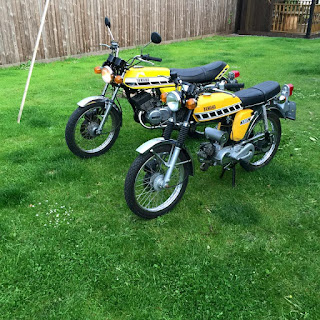
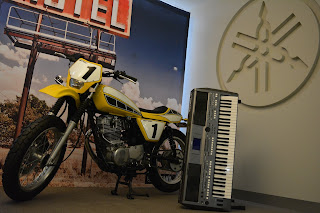
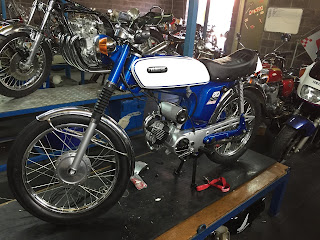
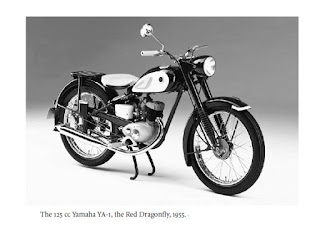
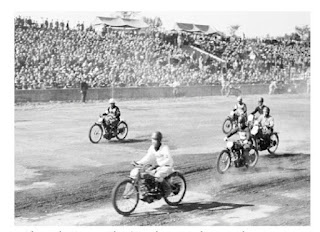
No comments:
Post a Comment